U.S. shale oil: The great railroad revival continues
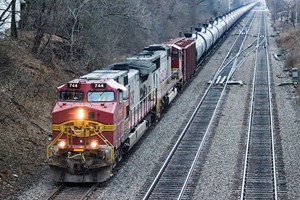
Crude oil by rail in the modern era is such a new phenomenon that nobody seems to have quite gotten their arms around it. Certainly not the railroads, who see their trains jump the tracks with alarming frequency. It’s a whole new world to oil producers, who turn to railroads reluctantly, because they have no choice, and to the refiners, some of whom love rail delivery, so long as it’s cheaper than other alternatives.
Most bewildered of all must be the pipeline companies, taken totally by surprise by the turn of events. In fact, a big chunk of the pipeline capacity leaving North Dakota stands idle these days, while most of the oil leaves by train.
John D. Rockefeller’s Standard Oil was among the first companies to use railroads to move oil, in the 1870s. Rockefeller also invested in oil pipelines, playing one mode of transportation against the other. Ultimately, the pipelines won. Railroads carried 162 MMbbl of crude in 1943, but just 28 MMbbl in 1953, and in 1963, a mere 5 MMbbl. The reason is obvious: All things being equal, from Point A to Point B, pipelines are cheaper.
What changed is that horizontal drilling and hydraulic fracturing made it possible to unlock the billions of barrels of oil trapped inside the Bakken shale in western North Dakota, eastern Montana and southern Saskatchewan. Led by Continental Resources, producers descended on the Bakken like ants at a picnic.
Suddenly, all things were not equal. As production in the Bakken surged, starting in 2012, it overwhelmed North Dakota’s modest pipeline infrastructure. Producers became desperate to move their oil to refiners. That’s how railroads got their second chance. Today, about a dozen trains per day, each containing some 75,000 bbl of oil, leave North Dakota. In all, railroads in 2014 handled 493,126 carloads of oil (355 MMbbl), up 20% from 2013’s level.
The collapse of oil prices last year ended chapter one of The Great Railroad Revival. Oil production in North Dakota appears to be peaking, as leases on drilling rigs expire. Now, for railroads, comes the hard part—holding on to this newly gotten business. Pricing anomalies that once worked in their favor have shrunk or disappeared. New pipeline capacity will soon come online in North Dakota. And the U.S. Department of Transportation has been looking at tough new safety measures that could raise the cost of using rail.
THE MANY ADVANTAGES
Price isn’t everything, and it turns out that railroads hold a few trump cards of their own. Pipelines are static, whereas railroads can take your oil to Louisiana today and to Delaware tomorrow—wherever the price is right. It takes years to develop a pipeline, but mere weeks or months to lease a train of tank cars. Pipelines demand take-or-pay commitments of up to 20 years, whereas rail contracts last months to a year.
But the highest trump held by railroads is that they go where pipelines do not, and perhaps never will. No pipelines extend from the oil fields in the central part of the U.S. to refineries on the Atlantic and Pacific coasts. Traditionally, East Coast refiners bought oil from West Africa, whereas those in California and Washington relied mostly on oil from Alaska’s North Slope. ANS prices largely match the world benchmark set in Brent.
As West Texas Intermediate crude began trading at a steep price discount to the Brent benchmark, coastal refiners stood at a competitive disadvantage to those with access to cheaper oil in the U.S. interior. At times, that discount exceeded $25/bbl, and a couple of the refineries clustered along the Delaware River near Philadelphia closed or announced plans to shutter.
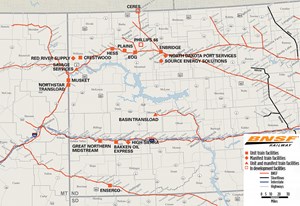
The availability of oil brought by rail from North Dakota at the WTI price became a godsend to these refiners, starting about 2012. If the cost of rail transport is $12/bbl, but the oil is pegged to the WTI price, refiners win, so long as the Brent-WTI spread is greater than $12. Not surprisingly, every refinery in the eastern U.S. and Canada by 2015 was being fed by the growing network of crude oil trains. Builders of tank cars had order backlogs that would take two years to fill.
Refineries on the West Coast, clustered in Washington state between Tacoma and the Canadian border, and in California, in San Francisco’s East Bay area and in Wilmington-Long Beach south of Los Angeles, became attracted to Bakken oil by rail for largely the same reason. Moreover, Alaskan production has declined relentlessly in recent years.
These became natural markets for crude by rail. But as we shall see, getting that oil from the heartland to either side of the U.S. is not so easy.
GATHERING NETWORK
Two giant railroads serve North Dakota’s oil fields. By far the biggest player is BNSF Railway—BNSF is an acronym for the combined, former Burlington Northern and Santa Fe railways (Editor’s note: BNSF Railway is wholly owned by Warren Buffet’s Berkshire Hathaway conglomerate). Its main line from Chicago to Seattle passes right through the Bakken formation in western North Dakota, Fig. 1. Leaving Minot, N.D., on Amtrak’s westbound Empire Builder, you see big loop tracks, each able to hold a 6,000-ft train while it is loaded, in the communities of Berthold, Epping, Manitou, Stanley, Tioga, Trenton and Williston. As many more oil load-outs are on secondary BNSF lines in the state.
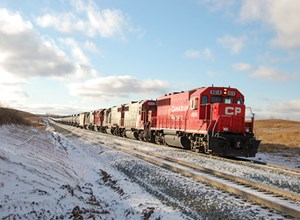
From these towns, BNSF crude oil trains head in three directions. About half of them are destined to East Coast refineries or distribution hubs, in Philadelphia and Eddystone, Pa.; Linden and Westville, N.J.; Delaware City, Del.; Albany, N.Y., and Yorktown, Va. The other trains go either west, to the four refineries in northwestern Washington state, or south toward the Gulf Coast.
The other large railroad is Canadian Pacific, which loads oil at three locales, on or near its tracks. Almost all of CP’s trains end up on the East Coast, getting there either via Canada or on an all-U.S. routing, Fig. 2.
Hand-in-hand with the oil come trainloads of frac sand. Most of this super-hard, specialty sand comes from quarries in northern Illinois and southern Wisconsin (but also from South Texas). As many as 30 42-ft cars of sand are required to drill a single well. About 90,000 carloads of sand were consumed just in North Dakota last year, Fig. 3.
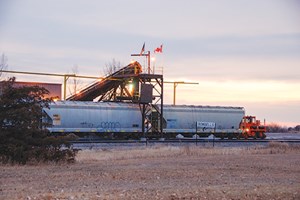
For railroads, this new business comes at a cost. BNSF simply became overwhelmed by the buildup, starting in 2013. Congestion extended from Chicago to the West Coast and spread southward. Executive Chairman Matt Rose admits his company was a year behind the curve. “I used to say, don’t invest until you see the whites of their eyes,” says Rose, referring to capacity expansions. “Now, I’m not so sure.” Not just crude oil crowded onto BNSF tracks. Trainloads of frac sand, strings of flat cars carrying drill pipe, and tank cars full of drilling and production chemicals all descended on North Dakota. The railroad industry expanded by 800,000 units in 2013, and half of that growth occurred just on BNSF Railway.
Crude oil and frac sand trains contributed to massive gridlock last year in Chicago, the railroad capital of the nation. Chicago is where Western railroads, such as BNSF, exchange freight cars and entire trains with Eastern railroads, such as CSX Transportation and Norfolk Southern, Fig. 4. Cindy Sanborn, executive vice president-operations of CSX, says it best: “When Chicago works, that’s where you want to go, because everyone’s there.”
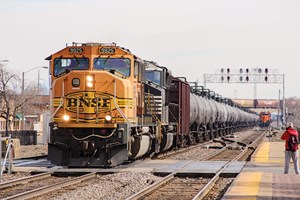
But when Chicago doesn’t work, it’s the worst place on earth. First the coldest winter in recorded history, and then a surge of oil and other business routed through Chicago, led to a meltdown and massive backup of trains that took all of 2014 to unravel.
MORE TROUBLE
Meanwhile, in the West, environmental groups, and politicians sympathetic to their cause, have taken aim at crude by rail. Efforts by California refiners, such as Valero Energy, to add unloading loop tracks have stalled in the permitting stage. Passions really boil over in Vancouver, Wash., across the Columbia River from Portland, Ore. There, Tesoro Corp. and Savage Companies seek to build a rail-to-water trans-loading terminal, so that oil can be taken inexpensively by vessels to California refineries (which, by the way, are already equipped to receive oil by water).
Two miles away from this proposed facility, and right next to the railroad tracks headed its way, is a $1.3-billion real estate project, also on the drawing board It would contain offices, shops and apartment towers. The New York Times reports that Vancouver’s city government is backing the real estate developer and opposing the Tesoro-Savage joint venture, betting that if the development gets underway first, the state will block the trans-load facility for safety reasons.
And who makes that decision? Why, the governor of Washington, Democrat Jay Inslee, who told a news conference in Seattle last year: “It’s Washington’s destiny to lead. We do not want to be addicted to gasoline anymore.”
It doesn’t help the railroads that their oil trains keep derailing, often accompanied by explosive fireballs (“Trains That Go Boom” headlined Bloomberg/Business Week). In one three-week period, from mid-February to early March, two oil trains in the U.S. and three in Canada derailed, and all but one derailment resulted in explosions, then fires that burned for days. The most disastrous wreck, in 2013, killed 47 people in Lac-Megantic, Que., when an unattended train rolled downhill and derailed at high speed on a curve in the center of the town.
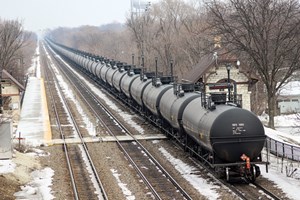
In response to Lac-Megantic, Canadian regulators mandated stronger tank cars. But all five of those derailments in February and March involved new CPC-1232 tank cars, heavier and supposedly safer in derailments than the older DOT-111 cars. Moreover, the derailments all occurred at speeds of less than 40 mph. There appears to be no pattern to the causes—a broken wheel here, a broken rail there, shifting roadbed, and defective switches all get the blame.
The U.S. Department of Transportation, this spring, as expected, has revealed new crude-by-rail regulations (see sidebar article on DOT’s actions), among them a requirement for still-stronger tank cars, Fig. 5. Yet so vicious are the forces unleashed by a derailment, that it’s practically impossible to prevent all punctures. One academic study circulating among railroads suggests a maximum safe speed of 20 mph for the newer CPC-1232 tankers and 15 mph for DOT-111 cars.
So it matters little that 99.995% of crude oil cars get where they’re headed just fine. The other 0.005% scare the hell out of people.
CANADA PLAYS CATCH-UP
Some 800 mi northwest of the Bakken is an even bigger oil field area, the Alberta oil sands. Bitumen is the name of the thick, gooey substance that is steam-heated to the surface, and for it to flow through a pipeline, you must dilute it 28% with condensate. Canadian oil producers put their bets on having pipelines built to terminals on the Pacific Coast, plus the Keystone XL pipeline to the Gulf of Mexico. Against opposition from First Nation (Indian) tribes in Canada and environmentalists in the U.S., those new pipelines aren’t being built yet. Only in 2013 did Canadians look seriously at rail, putting them about three years behind their U.S. counterparts.
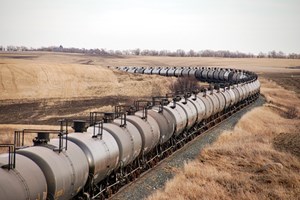
There is an irony at work here. The condensate makes a pipeline only 72% efficient. But new tank cars built with steam-heating coils inside them can be filled with pure bitumen. Randy Meyer, V.P. for corporate development at Altex Energy, figures the total cost of getting a barrel of bitumen from Fort McMurray, Alta., to the Gulf Coast at $22.41 by rail and $24.79, or more, by pipeline, Fig. 6.
So far, however, not a single unit train of pure bitumen has made it to Texas. First of all, there is no terminal in Canada capable of loading pure bitumen. Actually, the bitumen is diluted as it comes out of the ground, in order to flow through feeder pipelines from the oil fields. And no facility yet exists at the rail loading terminals to extract the condensate. It remains uncertain whether railroads will have a permanent role moving Canadian oil.
THE ROAD AHEAD
Crude by rail today is really a North Dakota phenomenon. Railroads load crude in Colorado, New Mexico, Utah and Wyoming, but in nowhere the volume of what comes out of the Bakken. So going forward, North Dakota is where the tug-of-war between train and pipeline will take place.
At the dawn of the great railroad revival in oil a few years ago, the common belief was that trains would be a bridge, a short-term fix for producers to use to get their oil out of the state until enough pipeline capacity was in place. In 2012, even the people at BNSF Railway believed this. They hoped, maybe, to hang on to a 20% market share. Perhaps that’s why the railroad didn’t expand capacity quickly enough on its Chicago-Seattle route.
By 2013, however, the BNSF folks were talking about a 70% share, long term. Their thinking went like this: Pipelines don’t go from the interior oil fields to the East or West Coasts, and probably never will. Refineries in these two regions have an appetite to process about 2 MMbbl of light, sweet crude oil per day, or twice the current production in the Bakken shale area. So if railroads, led by BNSF, can develop markets on those two coasts, their future in the business is assured.
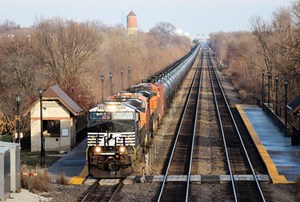
It’s a nifty idea from the railroads’ point of view, and some experts say it may actually work out that way. Taylor Robinson, president of PLG Consulting, is one of them. It’s no coincidence, he says, that one-third of the pipeline capacity already in place in North Dakota goes unused. “The pipelines go to the Midwest or to Cushing, the oil hub in Oklahoma,” he says. “They’ve filled the Midwest with light oil. But at Cushing, they compete with light oil from the Eagle Ford shale in South Texas, and the Permian basin in West Texas, and those fields are closer to Gulf Coast refineries, with even cheaper pipeline costs.”
His forecast—for U.S. crude-by-rail volume to hold steady through 2019 at about 800,000 bpd, the equivalent of 11 unit trains—is predicated on railroads’ keeping, and even expanding, their markets with East and West Coast refineries, Fig. 7. And it also assumes a WTI price of $50/bbl, although he suspects prices will drop lower in the short term, which they have. If railroads lose a great deal of that coastal business—for instance to supertankers from West Africa—then their future in the oil trade won’t be nearly as bright, he adds.
Energy economist Philip Verleger used to think the future of crude by rail was assured. “Rail offers refiners the ability to select from a larger number of sources,” he says. “And they prefer rail despite the higher cost, because the producer, not the refiner, incurs the transportation cost.” But Verleger is bothered by the rash of derailments, which he thinks will make pipelines more politically acceptable. His other concern relates to oil prices. So long as supply overwhelms demand, North Dakota production and, therefore, railroad haulage will be under pressure.
And consider this: The number of crude oil trains slipped at the end of winter, at least in part due to a low differential between the Brent and WTI prices. East Coast refiners, in other words, appear to be hedging their bets by bringing in more overseas oil by tanker. Meanwhile, environmental battles rage on the West Coast, and all-rail shipments to California from both North Dakota and Canada have ceased.
Good? Bad? What a spoiled crystal ball! The point is this: A quarter-of-a-century ago, railroads were given up as near-dead. Deregulated, they are re-entering markets that they long ago gave away to other modes. But in no other competitive faceoff are there so many unknowns. Unlike almost all other commodities, oil is a jump ball. This is becoming a test of railroad and pipeline dexterity. So far, in North Dakota, advantage rail. ![]()
- Shale technology: Bayesian variable pressure decline-curve analysis for shale gas wells (March 2024)
- What's new in production (February 2024)
- Prices and governmental policies combine to stymie Canadian upstream growth (February 2024)
- U.S. operators reduce activity as crude prices plunge (February 2024)
- U.S. producing gas wells increase despite low prices (February 2024)
- U.S. drilling: More of the same expected (February 2024)
- Applying ultra-deep LWD resistivity technology successfully in a SAGD operation (May 2019)
- Adoption of wireless intelligent completions advances (May 2019)
- Majors double down as takeaway crunch eases (April 2019)
- What’s new in well logging and formation evaluation (April 2019)
- Qualification of a 20,000-psi subsea BOP: A collaborative approach (February 2019)
- ConocoPhillips’ Greg Leveille sees rapid trajectory of technical advancement continuing (February 2019)


